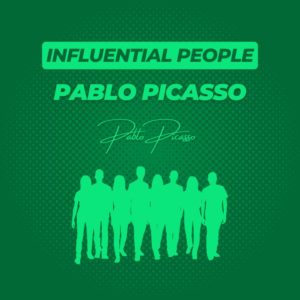Introduction to Pablo Picasso
Pablo Picasso stands as a titan of modern art, reshaping the artistic landscape of the 20th century with his relentless innovation and prolific output. Born in 1881 in Málaga, Spain, Picasso ventured beyond the traditional boundaries of painting and sculpture, introducing the world to radical forms and perspectives. His work not only revolutionised visual art but also mirrored the dynamic changes in society during his lifetime, including shifts in the ways people connect and relate to one another.
ways people connect and relate to one another.
Picasso’s artistic journey was marked by constant reinvention, from the melancholic tones of his Blue Period to the vibrant optimism of his Rose Period, and into the groundbreaking geometric abstraction of Cubism. Each phase of his work reflects a deep interplay between his personal experiences and broader cultural movements, showcasing how creativity can both influence and be influenced by personal relationships. This interconnection between art and life underscores themes relevant to today’s world of online dating, where authenticity and self-expression play pivotal roles in forming meaningful connections. As we explore Picasso’s life and legacy, we uncover insights into the transformative power of creativity in personal interactions and the continuous reshaping of our own identities.
Picasso’s Early Life and Artistic Beginnings
Pablo Picasso’s journey into the art world began in the vibrant streets of Málaga, Spain, where he was born to José Ruiz Blasco, a painter and art teacher, and María Picasso López. From a young age, Picasso exhibited an extraordinary artistic talent, nurtured under the tutelage of his father. By the age of seven, he was already proficient in traditional, academic techniques, a foundation that he would later both build upon and rebel against throughout his career.
Picasso’s family moved to Barcelona when he was a teenager, a city that at the turn of the century was a bubbling cauldron of artistic and cultural innovation. It was here, at the La Llotja Academy, that Picasso began to immerse himself in the modernist movements that permeated the city’s art scene. The vibrant cultural environment of Barcelona, combined with his studies, allowed Picasso to start developing his own artistic voice. His early works, characterised by their emotional depth and the use of sombre tones, were heavily influenced by Spanish art and culture but also hinted at his burgeoning desire to explore new and uncharted artistic territories.
The personal experiences Picasso had during these formative years deeply impacted his artistic evolution. His close relationship with his sister Lola and his grief over the death of his younger sister, Conchita, who died of diphtheria, profoundly affected him. These events are often reflected in the melancholic and introspective mood of his early works. Moreover, Picasso’s frequent visits to Els Quatre Gats, a café that served as a hub for intellectuals and artists in Barcelona, exposed him to a plethora of ideas and artistic styles, fuelling his desire to experiment and innovate.
As Picasso moved to Paris in the early 1900s, his exposure to a broader range of influences, including African art and the works of French artists like Henri Toulouse-Lautrec and Paul Cézanne, catalysed a dramatic transformation in his style. This period marked the beginning of a lifelong pattern of drawing inspiration from his surroundings and personal relationships, integrating them into his evolving artistic expression. Through this lens, Picasso’s early life and artistic beginnings set the stage for his revolutionary contributions to modern art, illustrating how personal history and relationships intricately weave into the fabric of creative expression. This dynamic interplay between life and art offers a compelling parallel to modern online interactions, where personal experiences and self-expression shape digital identities and connections.
Revolutionary Artistic Contributions
Pablo Picasso’s career is marked by distinct periods of artistic innovation, each reflecting deep personal experiences and broader cultural influences that reshaped the art world. His journey through these periods not only demonstrates his versatility and influence but also parallels the way personal and social relationships have evolved in the modern world.
Blue Period (1901-1904): Characterised by somber paintings in shades of blue and blue-green, Picasso’s Blue Period emerged during a time of emotional turmoil and financial hardship. The death of his close friend, Carlos Casagemas, profoundly impacted Picasso, infusing his works with themes of poverty, isolation, and human misery. Works like “La Vie” and “The Old Guitarist” depict gaunt figures that embody personal loss and social alienation. This period reflects how personal grief can profoundly affect one’s creative output, much like how personal crises today can transform individuals’ digital and social identities.
Rose Period (1904-1906): Moving away from the melancholic Blue Period, Picasso’s Rose Period is marked by a lighter palette and the introduction of warmer shades of orange and pink. This phase signifies a time of change and personal recovery, with more optimistic themes featuring circus performers and clowns, as seen in “Family of Saltimbanques”. The Rose Period illustrates Picasso’s resilience and ability to transform his art in response to his changing emotional and social circumstances, mirroring how individuals today adapt and grow through personal relationships.
African-Influenced Art (1907-1909): Inspired by African artefacts and sculptures, this period marked a significant departure from traditional European painting styles. Picasso’s iconic work “Les Demoiselles d’Avignon” broke away from conventional perspectives and introduced elements of abstraction and distortion. This bold experimentation symbolises the breaking of cultural boundaries and the integration of diverse influences, akin to how global interactions today reshape personal identities and social relationships.
Cubism (1909-1919): Developed with Georges Braque, Cubism represented a radical break with traditional perspectives, presenting subjects from multiple angles simultaneously. This style fragmented the world into geometric shapes, as seen in works like “Ma Jolie” and “Guernica”. Cubism’s deconstruction and reassembly of reality challenge viewers to see the world differently, paralleling modern innovations in communication that allow for multifaceted expressions of self in digital environments.
Picasso’s artistic revolutions resonated beyond the canvas, influencing numerous other fields and encouraging a continual reassessment of what constitutes art, identity, and connectivity. Just as Picasso reimagined the boundaries of art, today’s digital landscapes continually transform the boundaries of how people connect, interact, and understand each other, demonstrating that the essence of creativity lies in the ability to see and represent the world in novel ways. Through his work, Picasso teaches us that innovation, whether in art or in personal relationships, is born from a willingness to break conventions and explore new possibilities.
Picasso’s Personal Life and Relationships
Pablo Picasso’s artistic achievements were profoundly shaped by his personal life, particularly his relationships with various muses and partners. These relationships were not only pivotal in his life but also served as significant influences on his art, reflecting the complex interplay between personal dynamics and creative expression.
Muses and Partners
Picasso’s romantic relationships were as turbulent and transformative as the periods of his art. Fernande Olivier, his first long-term partner in Paris, influenced the early Cubist experiments. Her presence coincides with a shift in Picasso’s work towards more abstract and fragmented forms, as seen in his Cubist sculptures and paintings. Marie-Thérèse Walter inspired a period of sensuous curves and vibrant colours in Picasso’s work, epitomised by the voluptuous images in his paintings from the 1930s. Dora Maar, a photographer and painter herself, was not only a lover but also a collaborator during Picasso’s political art phase, including his work on “Guernica”. Her influence can be seen in the emotional intensity and stark political commentary of his art during this time.
Each relationship brought out different facets of Picasso’s character and creativity, highlighting how personal connections can significantly shape artistic output. This reflects modern concepts in online dating, where individuals are often influenced and inspired by their encounters and relationships, leading to personal growth and self-discovery.
Art Influencing Relationships
Conversely, Picasso’s own identity as an artist also affected his relationships. His relentless pursuit of artistic innovation often led to tumultuous relationships. For instance, Picasso’s constant need for creative stimulation and recognition affected his partners, often leaving them feeling overshadowed or neglected. This dynamic showcases the potential challenges in relationships where one person’s career or passions dominate, a situation quite relatable in today’s context where balancing personal ambitions with relationship goals is a common struggle.
Drawing Parallels to Modern Dating
Just as Picasso’s relationships influenced his art, personal dynamics in the digital age can drive creativity and expression in online platforms. In modern dating, personal profiles, much like art, are curated representations that people use to express themselves and attract partners. The interactions and relationships formed through these platforms can significantly influence one’s self-perception and public persona, much like how Picasso’s companions influenced different aspects of his work.
This section of the article can emphasise how the intertwined relationship between Picasso’s personal life and his art reflects broader themes relevant to online dating today—themes of influence, transformation, and the profound impact personal relationships can have on individual expression and creativity.
Picasso’s Legacy and Influence on Modern Culture
Pablo Picasso’s impact on the world extends far beyond the confines of the art galleries that house his work. His legacy is a testament to the enduring power of innovation and creativity, influencing not only contemporary art but also wider cultural norms and personal expressions.
Enduring Impact on Contemporary Art
Picasso’s contributions to modern art are monumental, reshaping not just artistic techniques but also the very concept of what art could be. His pioneering of Cubism challenged traditional perspectives, introducing a way to view the world through multiple lenses simultaneously, a technique that continues to inspire artists today. Additionally, his willingness to experiment with different materials and forms broadened the scope of artistic expression, encouraging future generations to push the boundaries of their creativity.
Influence on Popular Culture and Media
Beyond the canvas, Picasso’s influence permeates modern design, advertising, and media. His style and techniques can be seen in the geometric shapes and abstract forms used in various design fields, including fashion, graphic design, and architecture. His approach to breaking down forms and reconstructing them in abstract ways has also paralleled developments in film and digital media, where nonlinear narratives and fragmented visuals have become more prevalent.
Connection to Self-Expression and Authenticity in Online Dating
Picasso’s art, characterised by its raw emotional power and bold distortion of reality, encourages a deeper exploration of identity and self-expression—concepts at the heart of modern online dating. In the digital age, individuals curate their online profiles much like artists select elements for a canvas, choosing which parts of their identity to highlight or obscure. Picasso’s emphasis on multiple perspectives and complex, layered representations offers a valuable metaphor for online personal branding, where individuals are tasked with encapsulating their multifaceted personalities in a single, cohesive profile.
Moreover, Picasso’s personal branding as an artist—his public persona as much a part of his art as his paintings—mirrors how individuals today craft their digital identities. Just as Picasso was both influenced by and influential on his muses and the public, so too do modern online daters influence and are influenced by the cultural norms and expectations they engage with online.
Cultural Relevance and Ongoing Dialogue
Picasso’s legacy prompts an ongoing dialogue about the nature of art and identity, urging contemporary society to question and redefine conventional norms. This dialogue resonates with the current trends in online dating, where questions of authenticity, representation, and personal connection are ever-present. Just as Picasso challenged viewers to see beyond the surface to the deeper meanings behind his fragmented subjects, online daters navigate the complex interplay between appearance and reality, crafting identities that resonate with both their true selves and potential partners.
Picasso’s legacy offers rich insights into the power of creativity and self-expression, providing a robust framework for understanding the dynamics of modern relationships and the continuous evolution of cultural and personal identities.
Lessons from Picasso for Modern Online Daters
Pablo Picasso’s life and work provide rich lessons in embracing individuality and the transformative power of creativity. These lessons are particularly resonant in the realm of modern online dating, where expressing one’s unique self can lead to more meaningful connections.
Embrace Individuality
Picasso never shied away from expressing his true self through his art, regardless of the prevailing trends or opinions of his time. His bold departure from traditional forms and his development of new styles like Cubism and Surrealism show a profound commitment to individuality. For online daters, Picasso’s approach underscores the importance of embracing one’s unique traits and experiences. In a sea of profiles, authenticity stands out, and being true to oneself attracts those who appreciate one’s genuine qualities.
Creativity as a Form of Expression
Throughout his career, Picasso experimented with different styles, materials, and themes, constantly evolving his artistic expression. He treated each new period as an opportunity to explore different aspects of his personality and worldview. Similarly, online dating profiles should not be static; they can evolve and change as one grows. Utilising creative ways to express hobbies, passions, and desires—through photographs, choice of words, or even the overall theme of the profile—can make a profile more engaging and a true reflection of one’s personality.
Learning from Relationships
Picasso’s relationships deeply influenced his artwork, providing new perspectives and inspiring different themes and techniques. Each relationship can teach something valuable about oneself, whether it ends in success or disappointment. Online daters can take this lesson to heart by reflecting on past relationships to gain insights into what they truly value and seek in a partner, using these insights to refine their approach to finding new connections.
Risk-Taking in the Pursuit of Fulfilment
Just as Picasso ventured into unexplored artistic territories, online daters can benefit from stepping outside their comfort zones. This might mean reaching out to someone who might not seem like a perfect match at first glance or trying new ways to communicate and share experiences. Taking risks can lead to unexpected, enriching experiences, much like Picasso’s forays into different artistic movements brought him renewed creativity and recognition.
Cultivating a Dynamic Self-Image
Picasso viewed his identity as multifaceted, never allowing himself to be defined by a single style or period. This dynamic self-image is crucial in online dating, where presenting oneself as a multi-dimensional individual can lead to deeper and more varied interactions. Acknowledging and presenting the complexity of one’s character and interests can attract like-minded individuals who appreciate depth and complexity.
Picasso’s artistic journey offers valuable insights for online daters today. By embracing individuality, expressing oneself creatively, learning from personal relationships, taking risks, and maintaining a dynamic self-image, individuals can navigate the world of online dating with confidence and authenticity. These principles not only enhance one’s dating profile but also enrich one’s approach to relationships and personal growth, echoing Picasso’s lifelong dedication to evolving his art and himself.
Conclusion
Pablo Picasso’s artistic legacy is a profound narrative of innovation and self-expression that continues to resonate deeply with contemporary themes of identity and connection. His groundbreaking contributions to art—characterised by constant evolution, bold experimentation, and a unique blend of personal and cultural influences—mirror the dynamics of modern personal relationships, particularly in the realm of online dating.
Picasso taught us that embracing our complexities not only enriches our own lives but also enhances our interactions with others. His ability to continually redefine his artistic identity, drawing on a diverse range of influences and experiences, reflects the modern journey of self-discovery in a digitally connected world. In online dating, presenting oneself authentically, akin to how Picasso presented his evolving styles, encourages genuine connections and allows for relationships built on a true understanding and appreciation of one another.
Embracing our complexities, much like Picasso did with each brushstroke, can lead to deeper and more meaningful interactions. It prompts us to consider that the most fulfilling connections are often those that recognise and celebrate the multifaceted nature of our personalities. By inviting a world of viewers—past, present, and future—to engage with his ever-changing artistic expressions, Picasso exemplifies how embracing our full selves can lead to a richer, more colourful tapestry of human experience.
In the pursuit of personal connections, whether through art or online dating, let us take a page from Picasso’s sketchbook: boldly express our nuances, continuously reinvent our perspectives, and cherish the diverse interactions that shape our lives. In doing so, we not only honour Picasso’s legacy but also contribute to a more vibrant and understanding world.






